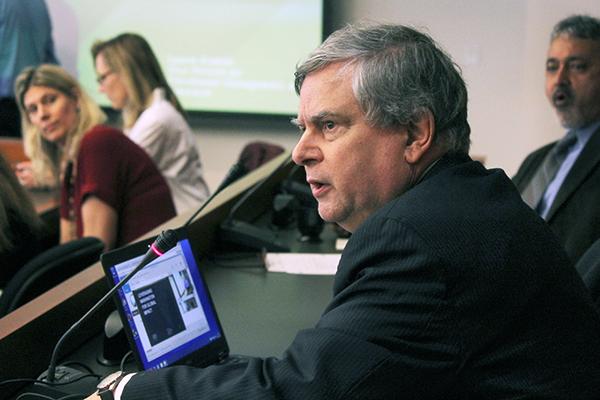Travel is no excuse to skip a Faculty Senate meeting anymore.
A Faculty Senate task force tested out webcam technology at a meeting earlier this month that would allow members to remotely participate and potentially vote from afar. The webcam service is already available to faculty and staff through the service WebEx and faculty say it could help increase participation in the meetings.
Philip Wirtz, a professor of decision sciences and psychology, said the group, made up of both faculty and administrators, is still in the early stages of testing and will run more tests before creating formal proposals for the Faculty Senate and the Faculty Assembly.
“We want to understand what’s possible and what the limitations are,” Wirtz said in an email. “It remains to be determined by the respective bodies whether, given feasibility, the bodies deem it acceptable.”
Wirtz said the committee will first determine the possibility of using large-scale remote participation in the Faculty Assembly, which consists of all faculty at GW and meets once a year, and then will address the feasibility of remote voting. Faculty hope to use October’s Faculty Assembly meeting as a trial run for this technology.
Charles Garris, the chair of the Faculty Senate’s executive committee, said that because many faculty members often travel and are busy with research, they are not always able to attend the body’s yearly meeting.
“Nobody is looking for meetings to go to,” Garris said.
He added that although the body is made up of nearly 2,000 members, only 125 faculty members need to attend to hold a vote.
“Is a quorum of 125 really representative of anything?” Garris said. “It would be better if people who can’t attend could participate remotely.”
Garris said the biggest challenge with remote voting is that the current procedures of the Faculty Assembly allow for secret ballots to be used at times. While webcam technology would make it easy for remote faculty to vote by show of hands, Garris said the task force has not yet determined a way to handle secret voting.
Steve Charnovitz, an associate professor of law and a member of the group testing the technology, said in an email that the size of the Faculty Assembly could pose technological challenges.
“It’s one thing to do a video conference call of five individuals, quite another to do one with 500 individuals,” Charnovitz said. “We are adopting an incremental approach of testing and evaluation.”
Charnovitz said this advancement could require amendments to the faculty organization plan, which outlines procedures for the Faculty Senate and Faculty Assembly. Because these bodies have never employed remote voting in the past, there are no guidelines or procedures in place for how to execute and involve the new technology.
He said that for now, the task force will continue to test different forms of technology to determine the feasibility and effectiveness of remote voting.
“Any reasonable procedure that could facilitate participation is good for the faculty as a democratic community,” Charnovitz said.








